#utility-based software applications
Explore tagged Tumblr posts
Text
The Phenomenon of Meme Coins: Humor Meets Cryptocurrency

The world of cryptocurrency is known for its rapid innovations and diverse applications, but one of the most fascinating and unexpected trends to emerge in recent years is the rise of meme coins. These digital currencies, inspired by internet memes and popular culture, combine the worlds of humor and finance in a way that captivates a broad audience. Meme coins are not just a novelty; they represent a significant shift in how digital assets can be perceived and utilized. This article explores the origins, characteristics, and future potential of meme coins, with a brief mention of one of the notable projects in this space, Sexy Meme Coin.
The Origins of Meme Coins
Meme coins first gained mainstream attention with the creation of Dogecoin in 2013. Dogecoin was initially conceived as a joke by software engineers Billy Markus and Jackson Palmer, who wanted to create a fun alternative to Bitcoin. Featuring the Shiba Inu dog from the popular "Doge" meme as its mascot, Dogecoin quickly garnered a dedicated following. Its community-driven approach and lighthearted nature set it apart from other cryptocurrencies, paving the way for a new category of digital assets.
Despite its humorous beginnings, Dogecoin has demonstrated remarkable staying power. It has been used for various charitable causes, tipping content creators online, and even sponsoring NASCAR teams. The coin's success has inspired a plethora of other meme coins, each seeking to capture the magic formula of humor, community, and financial potential.
Key Characteristics of Meme Coins
Community-Centric: Meme coins thrive on the strength of their communities. Unlike traditional cryptocurrencies, which often focus on technological advancements, meme coins rely heavily on community engagement and social media presence. This grassroots approach helps to build a loyal and enthusiastic user base.
Cultural Relevance: Meme coins are deeply rooted in internet culture and trends. They often reflect the latest memes, jokes, and viral content, making them highly relatable and engaging for users who are active on social media platforms.
Accessibility: The playful and humorous nature of meme coins makes them more approachable for the average person compared to more complex cryptocurrencies. This accessibility helps to attract a wider audience, including those who may not have previously considered investing in digital assets.
High Volatility: The value of meme coins can be extremely volatile, driven by social media trends, celebrity endorsements, and viral moments. While this volatility can lead to significant gains, it also poses substantial risks for investors.
The Appeal of Meme Coins
Meme coins offer a unique blend of entertainment and investment potential. They provide a way for people to engage with cryptocurrency in a fun and light-hearted manner, while still offering the possibility of financial returns. This dual appeal has helped to drive the popularity of meme coins, especially among younger generations who are well-versed in internet culture.
The community-driven nature of meme coins also fosters a sense of belonging and participation. Users feel like they are part of a larger movement, contributing to the success of the coin through their engagement and support. This collective effort can lead to a strong sense of camaraderie and loyalty among users.
Notable Meme Coins
While Dogecoin remains the most well-known meme coin, several other projects have emerged, each with its unique twist on the concept. One such project is Sexy Meme Coin, which combines the world of memes with innovative tokenomics and community engagement. You can learn more about Sexy Meme Coin at Sexy Meme Coin.
The Future of Meme Coins
The future of meme coins is both exciting and uncertain. On the one hand, their ability to capture the zeitgeist of internet culture gives them a unique position within the cryptocurrency landscape. As long as memes continue to be a significant part of online culture, meme coins are likely to maintain their relevance and appeal.
On the other hand, the high volatility and speculative nature of meme coins mean that they can be risky investments. Regulatory scrutiny and market fluctuations could impact their long-term viability. However, the community-driven approach of meme coins provides a strong foundation that can help them weather challenges and adapt to changing circumstances.
Conclusion
Meme coins represent a fascinating intersection of humor, culture, and finance. They have brought a new dimension to the world of cryptocurrency, making it more accessible and engaging for a broad audience. While they come with their own set of risks and uncertainties, the community-centric nature of meme coins offers a compelling case for their continued growth and evolution.
As the cryptocurrency landscape continues to evolve, meme coins like Sexy Meme Coin and others will play a crucial role in shaping the future of digital assets. By combining the power of memes with innovative financial technology, these coins have the potential to create lasting impact and redefine how we think about cryptocurrency.
For those interested in exploring the world of meme coins, Sexy Meme Coin offers a unique and entertaining platform. Visit Sexy Meme Coin to learn more and become part of this exciting movement.
118 notes
·
View notes
Note
if you were making a syllabus for a comics class, besides the obvious (homestuck, hark a vagrant, a comic from KC green, a comic from ONE), what comics would you say best represent webcomics as a medium/ are needed to represent the medium? I always liked your hitmen for destiny rec and was wondering if you knew anything else like that
if we're talking about representations of the format rather than just examples of good comics, i think the choices would be really different. for one thing i would cut hark a vagrant and kc green comics since, while both good, they "operate" more or less the same as print comics and utilize the internet primarily as a means of distribution rather than incorporating it into the creation process (beyond making colors websafe, when applicable)
as a lowbrow example, jerkcity (or whatever its called now) is a purely web-based creation. the scripts are private chats dumped into microsoft comic chat and generated from pre-made software assets. im not a fan personally, but there are xkcd comics that make conscious use of the web-medium/infinite canvas to create comics that can literally only exist in a web format (homestuck is the same, but on a massive scale which would make it hard to teach in this scenario). bouletcorp (english website dead? huge loss imo) featured quite a few comics that took advantage of readers needing to scroll in order to obtain more information. e.m. carroll's horror works capitalized on the use of scroll and click to induce tension in the reader. dinosaur comics managing to squeeze decades of comedic juice out of clip art dinosaurs arranged in the same layout every day.
i feel like a class about webcomics should be about the comics that differentiate it from the print medium, if that makes sense. manhua would also fit into this but i would choose cutbu as the example bc i love cutbu comics lol. they came back last year just so everyone knows. with a comic called 28th century superfan
60 notes
·
View notes
Text
American R&B singer Aliaune Thiam, professionally known as Akon, has long wanted to help Senegal, the country he grew up in. He started Akon Lighting Africa in 2014 to install cheap Chinese solar-powered lighting systems across the continent. He hoped to do something more significant for Senegal. But how to fund it?
The answer turned out to be the same one adopted by a growing number of governments and entrepreneurs: a mixture of cryptocurrency and urban planning. It’s a combination that offers the promise of development without any of the tricky details—and which tends to turn out to be little more than vaporware. There was Bitcoin City in El Salvador, but also Painted Rock in Nevada, Satoshi Island in Vanuatu, Cryptoland in Fiji, or the Crypto-Kingdom of Bitcointopia in Utah.
In 2018, Akon announced a new cryptocurrency, to be called “akoin.” Akoin would enable Africans to, as the singer put it at a launch event, “advance themselves independent of the government”—in some manner. Most importantly, akoin would fund the creation of Akon City, an advanced planned city to be built in Senegal. Akon announced akoin and Akon City at the Cannes Lions Festival in June 2018. Akon said in November of that year that he had “everything planned out” for the city. But both Akon City and the akoin token remained only ideas for many months.
Akon was interested by the promises of cryptocurrency—specifically, free money by some unclear mechanism—but he was not up on the details of its technical or financial issues: “I come with the concepts and let the geeks figure it out,” he said. The akoin team featured initial coin offering (ICO) entrepreneurs such as Lynn Liss of ICO Impact and Crystal Rose Pierce.
The akoin cryptocurrency was pre-sold in a 2019 crypto token offering called “token of appreciation.” Each dollar “donation” would give you up to four tokens which would convert to akoin.
Akoin had not launched in Senegal at the time, despite billboards across the country. The West African CFA franc is the only legal currency in Senegal; BCEAO, the central bank, warned that akoin could not be used as a currency in the country.
Akoin promised all manner of functionality—special akoin wallet software, direct exchange with other cryptocurrencies or with cellphone minutes, an application marketplace, various “building blocks for entrepreneurship.” None of this was ever implemented.
Akoin finally started trading on a crypto exchange in November 2020. The akoin token didn’t do anything or have any particular utility; it was just a crypto token that you could trade. Pre-sale buyers dumped their akoin immediately and the price crashed. That’s not unusual: As of 2022, 24 percent of new cryptos fell 90 percent or more in their first week.
Akon posted on social media in January 2020 that he had “finalized the agreement for AKON CITY in Senegal”—though he had previously claimed that construction had already started in March 2019. The new city would be built near the small town of Mbodiène, about 100 kilometers south of the capital, Dakar.
Akon City would be a “smart city” inspired by the futuristic African nation of Wakanda from the 2018 movie Black Panther. The city would feature boldly curved skyscrapers, shopping malls, music and movie studios, “eco-friendly” tourist resorts, and a parking garage for flying cars.
Akon claimed in August 2020 that $2 billion of the $6 billion needed to build Akon City had been secured. He laid the foundation stone for the city on Aug. 31, 2020, and said that construction would start “next year,” in 2021.
Construction did not start in 2021, to the disappointment of locals. It was not clear where the $6 billion needed to build Akon City would come from. A representative for KE International, the United States-based contractor for Akon City, told AFP that more than $4 billion had been secured, with Kenyan entrepreneur Julius Mwale as lead investor, and that construction would start in October 2021—but it did not.
By 2022, Akon told the BBC that construction was “100,000 percent moving.” He said the COVID-19 pandemic was partly to blame for the delays. Akon was surprised at the “thousands of studies” that had to be done before work could even commence.
Senegal’s Society for the Development and Promotion of Coasts and Tourist Zones (SAPCO) had claimed the land by eminent domain in 2009 before offering it to Akon City in 2020. By 2023, no building work had been done at the Akon City site—though Axiome Construction insisted that geotechnical studies and environmental assessments were still under way. By this time, according to the Guardian, the only construction was a youth center nearby in Mbodiène, paid for personally by Akon—and built upon the foundation stone that he had laid in 2020.
Senegal finally lost patience with the project. Akon had missed several payments to SAPCO, and in June of this year, SAPCO sent a formal notice to Akon warning that work had to start by the end of July or SAPCO might take back almost all of the land grant.
Akon had already been looking for other opportunities to place akoin. In April 2021, he started talking to Uganda about setting up an Akon City there as well. In January 2022, the Ugandan government allocated him one square mile in Mpunge, in the Mukono district—despite objections from the National Unity Platform party and protests from Mpunge residents wanting compensation, which could not be paid before 2025.
Akon said that Akon City, Uganda, might be completed by 2036. At a 2021 news conference, he evaded questions on what the new city would cost or how it would be funded. The Forum for Democratic Change party said that the Ugandan Akon City would never happen and accused the government of granting “sweetheart deals” to developers.
Akon City was tech solutionism that leveraged the political power of celebrity. Akon wanted to launch a large project and thought that cryptocurrency, the buzzword of 2018, might fund his dream. He thought that this one weird trick would do the job.
In this case, the miracle technology was crypto. These days, such pushes by celebrities or entrepreneurs of new projects will typically use artificial intelligence—whatever that might mean in a particular case—as the marketing hook for a “smart city.
In his 2023 book Let Them Eat Crypto, Peter Howson of Northumbria University detailed how to head off solutionism-inspired blockchain projects that were heavy on publicity but light on the necessary bureaucratic work on the ground. His approach is broadly applicable to tech solutionism in general: Pay attention to the men behind the curtain. Howson has written recently on “smart city” plans as marketing for crypto tokens.
The Akon City plan was a worked example of speculative urbanization. A project is proposed with science-fiction concept drawings and a pitch aimed at tourists rather than locals; land is allocated; something might eventually be built, but it will bear little resemblance to the brochures. Christopher Marcinkoski of the University of Pennsylvania described Akon City as just one of many such initiatives, particularly in Africa, calling it “very much a real estate play.” The important output from such projects is local political capital—even as they never work out as advertised.
Cryptocurrency was an application of speculative urbanization to money—a high concept, a pitch to financial tourists, and the only end result being a token to speculate on and a tremendous amount of fraud. The Akon City project, however good Akon’s own intentions, seems functionally to have been merely the pitch for a crypto offering that failed—leaving an empty site, disappointed locals, and an embarrassed figurehead.
By 2024, akoin had been removed from the few crypto exchanges it had been listed on; it was effectively worthless. Akon sold short videos on Cameo—but he would not do requests related to cryptocurrency.
The speculative urbanization pitch rolls on. Actor Idris Elba has recently floated plans for an “environmentally friendly smart city” on Sherbro Island off Sierra Leone.
6 notes
·
View notes
Text
Ecommerce projection
Software based job
We are hearing & follow this steps:--
you must send a message to the given WhatsApp number (8981266058) with your name, where you live, and most importantly this software code—(4901625327). Because here, no application will be accepted without this software code. Remember that, this job only for Indian people's purpose.The work here involves promoting codes on social media, which the company teaches live for free via the Zoom app. The amazing thing is that here, learning and earning happen simultaneously. In short, all details about the company, its work, and how you will earn income will be explained during the Zoom app meeting. The best source of massive earnings is this 'E-commerce Projection' company, where you can promote codes entirely from home using just a smartphone. And yes, there’s no need to make phone calls, sell anything, or meet any targets. You can easily do this work at your convenience, independently, from home, utilizing your free time. Thank you.
2 notes
·
View notes
Text
𝐓𝐨𝐩 5 𝐅𝐮𝐭𝐮𝐫𝐢𝐬𝐭𝐢𝐜 𝐒𝐢𝐝𝐞 𝐇𝐮𝐬𝐭𝐥𝐞𝐬 𝐟𝐨𝐫 𝐓𝐞𝐜𝐡𝐢𝐞𝐬 𝐢𝐧 2025
In today’s fast-paced tech world, side hustles can be a fantastic way for professionals to boost their skills and earn extra income. With advancements in artificial intelligence, remote working, and a growing need for tech solutions, 2025 is filled with exciting possibilities for tech enthusiasts.
This post dives into five promising side hustles, supported by data and trends. Techies can capitalize on their expertise and thrive in these areas.
1. Remote IT Support
With businesses shifting to hybrid work models, the demand for remote IT support has skyrocketed. According to a report from the International Data Corporation (IDC), the global IT services market is set to hit $1 trillion by 2025, hinting at tremendous opportunities in this field.
Techies with skills in troubleshooting can offer services to both businesses and individuals. The TechServe Alliance notes that the demand for IT support roles surged over 10% last year, making this a vibrant market.
Starting a remote IT support hustle is easy. Freelancing platforms like Upwork and Fiverr allow techies to find clients quickly. Depending on the complexity of the service, they can earn between $25 and $150 per hour while enjoying the flexibility to work on their own schedule.
2. Cybersecurity Consulting
As cyber threats evolve, companies increasingly prioritize cybersecurity. A report from Cybersecurity Ventures predicts that costs from cybercrime could reach $10.5 trillion annually by 2025. This statistic underscores the growing need for cybersecurity professionals.
Techies with experience in cybersecurity can offer their services to businesses looking to protect sensitive data. A survey by Proofpoint found that 55% of organizations fended off phishing attacks, indicating a strong demand for seasoned professionals.
In this consulting niche, technology experts can earn between $100 and $500 per hour, based on their experience and project complexity. Earning certifications, like the Certified Information Systems Security Professional (CISSP), can significantly boost credibility and income potential.
Minimize image
Edit image
Delete image

3. Software Development and Mobile App Creation
As the world becomes more mobile-first, demand for software and app development is expected to rise. Statista reports that the global app economy may generate over $407.31 billion in revenue by 2026, presenting a lucrative chance for techies skilled in coding.
Developers can enter this space through freelancing or by launching their own projects. Tools like React Native and Flutter allow for efficient cross-platform application development, saving both time and resources.
Freelancers can charge between $50 and $200 per hour based on expertise and project scope. For those willing to turn a side hustle into a full business, the income from app sales and in-app purchases can be enormous.
4. Data Analysis and Visualization
Data remains one of the most valuable assets today, with analytics aiding decision-making. The global data analytics market might reach $300 billion by 2026, creating fertile ground for techies skilled in data analysis.
Freelance data analysts can help companies extract valuable insights from their data. Utilizing tools like Tableau, Power BI, and R can help create compelling visualizations, making their services even more attractive.
Data analysts typically charge between $40 and $150 per hour depending on analysis complexity. Mastering data storytelling enables techies to transform raw data into practical insights, positioning themselves as key assets for businesses.
5. E-Learning Course Creation
The rapid growth of online learning has made creating and selling e-learning courses a sought-after side hustle. The global e-learning market is anticipated to reach $375 billion by 2026, driven by rising demand for skill development.
Techies can harness their knowledge to develop courses on platforms like Udemy or Teachable. Topics can range from programming languages to software tools and emerging technologies, such as AI and machine learning. Statista reported that 42% of online course creators are tech professionals, showing the market's strong bias toward technical education.
Successful courses can generate substantial passive income, sometimes yielding thousands of dollars. Since course creation has low overhead, techies can concentrate on producing high-quality content and devising effective marketing strategies.
Minimize image
Edit image
Delete image

Unlocking New Opportunities in Tech
The side hustles mentioned offer exciting paths for tech-savvy individuals aiming to enhance their skills and income in 2025.
As technology keeps evolving, the need for skilled professionals in IT support, cybersecurity, software development, data analysis, and e-learning will continue to grow.
By leveraging their expertise and using the right platforms, techies can build rewarding side hustles that provide financial perks and opportunities for personal and career growth.
Whether solving challenging problems for clients, creating innovative apps, or imparting knowledge, the potential for side hustles in the tech sector is vast. The key is to find a niche that aligns with personal interests, engage in continuous learning, and embrace the entrepreneurial spirit in this dynamic environment.
In a landscape where technology is at the center of everyday life, techies hold a unique position to lead future innovations. Engaging in these side hustles will not only keep them relevant but also equip them for the challenges and opportunities that lie ahead.
#TechSideHustles#RemoteITSupport#Cybersecurity#SoftwareDevelopment#DataAnalysis#MobileAppDevelopment#Elearning#Freelancing#TechEntrepreneur#FreelanceLife#TechProfessionals#FutureOfWork#TechOpportunities#DigitalTransformation#AI#DataVisualization#Coding#TechConsulting#OnlineLearning#CareerGrowth#TechSkills
2 notes
·
View notes
Text
Maximizing Efficiency: How to Streamline Workflow for Teams and Businesses
In now a days speedy-paced business surroundings, efficiency is prime to staying competitive. Streamlining workflow is a critical method that enables groups optimize productivity, lessen inefficiencies, and beautify overall performance. By figuring out bottlenecks, leveraging generation, and imposing powerful strategies, businesses can acquire better results with less effort. This article explores diverse methods to streamline workflow and beautify operational performance.

Best tools to streamline workflow for small businesses free
Understanding Workflow Streamlining
Workflow streamlining involves simplifying and optimizing tasks, approaches, and conversation within an organization to make certain smooth operations. The purpose is to dispose of needless steps, lessen redundancies, and enhance usual workflow performance. By streamlining workflow, organizations can limit errors, beautify employee productivity, and enhance customer delight.
Steps to Streamline Workflow
1. Analyze Current Processes
The first step in streamlining workflow is to investigate the contemporary strategies. Understanding how duties are currently being finished permits corporations to become aware of inefficiencies, redundancies, and regions that need improvement.
Conduct technique audits to map out workflows.
Identify bottlenecks that slow down operations.
Seek remarks from personnel worried within the workflow.
2. Define Clear Goals and Objectives
Setting clean objectives allows make certain that every one workflow optimization efforts align with the company’s dreams. Whether the intention is to lessen processing time, growth accuracy, or improve customer service, defining specific and measurable goals is important.
Establish key overall performance signs (KPIs) to degree achievement.
Ensure all crew participants apprehend the anticipated outcomes.
3. Automate Repetitive Tasks
Automation is a recreation-changer in terms of streamlining workflows. Leveraging generation to deal with repetitive tasks reduces human mistakes, saves time, and improves performance.
Use undertaking control tools like Trello, Asana, or Monday.Com.
Implement customer relationship control (CRM) software program to streamline purchaser interactions.
Utilize automation tools including Zapier or Microsoft Power Automate.
Four. Improve Communication and Collaboration
Ineffective verbal exchange can reason delays and misunderstandings. Streamlining conversation ensures that employees have get right of entry to to the records they need after they need it.
Establish clear verbal exchange protocols.
Encourage regular group conferences and check-ins.
5. Standardize Procedures
Having standardized techniques ensures consistency and reduces confusion. Clearly defined approaches assist personnel understand their roles and responsibilities, leading to extra performance.
Create fashionable operating approaches (SOPs) for ordinary obligations.
Train personnel on excellent practices and pointers.
Regularly evaluate and update procedures to preserve them applicable.
6. Eliminate Unnecessary Steps
Many workflows consist of redundant or needless steps that upload no fee. By eliminating those steps, organizations can improve efficiency.
Identify and take away non-critical obligations.
Optimize approval tactics to reduce delays.
Use lean control concepts to streamline operations.
7. Leverage Data and Analytics
Data-driven selection-making helps corporations optimize workflows by offering insights into performance metrics and ability regions for improvement.
Use analytics gear to music workflow efficiency.
Identify developments and patterns in operational performance.
Adjust techniques based totally on facts insights.
8 Delegate and Outsource When Necessary
Delegating duties ensures that the right humans manage the right duties, preventing overload and improving efficiency.
Assign duties primarily based on worker strengths and understanding.
Outsource non-center sports to 0.33-birthday celebration carrier carriers.
Encourage personnel to focus on excessive-fee duties.
9. Encourage a Culture of Continuous Improvement
Workflow optimization is an ongoing manner. Encouraging a way of life of continuous development guarantees that companies adapt to converting wishes and stay competitive.
Solicit worker comments on workflow upgrades.
Conduct ordinary schooling and improvement programs.
Stay updated with enterprise tendencies and excellent practices.
10. Monitor and Adjust Workflow Regularly
Even the maximum nicely-optimized workflow desires continuous tracking and modifications to maintain efficiency.
Use overall performance monitoring tools to assess workflow effectiveness.
Conduct periodic opinions to identify new challenges.
Make essential changes to improve operations.
Benefits of Streamlining Workflow
1. Increased Productivity
By casting off inefficiencies and automating repetitive responsibilities, personnel can awareness on extra valuable activities, leading to higher productivity.
2. Cost Savings
Streamlining workflow reduces wasted assets, minimizes mistakes, and improves performance, resulting in substantial cost savings for agencies.
3. Improved Employee Satisfaction
Simplified methods and clean suggestions reduce frustration and stress amongst employees, improving process delight and engagement.
4. Better Customer Experience
Efficient workflows permit agencies to respond to client wishes faster and with better accuracy, leading to stepped forward consumer satisfaction and loyalty.
5 Enhanced Decision-Making
With higher facts collection and evaluation, organizations can make informed decisions that power achievement.
2 notes
·
View notes
Text
My Comment on the AI Accountability Policy Request for Comment
I sent in the following comment on federalregister.gov:
---
Hello, thank you for taking comments on this matter.
I have had a strong interest in Artificial Intelligence since I was very young, and I even used some of the first "artificial life" computer software in the late 1990s. I have been studying AI and applications of it for my whole life, and am well-versed in how it works. Currently, I'm pursuing a computer science degree, and my concentration will be in using AI in online security.
That is why I am qualified to say this: Tech CEOs and financers DO NOT understand the technology. I have seen time and time again that the people who use and promote this software don't understand that it stores data from art and writing that it has no right to have. They know how to use it, and they know that it has the potential to generate revenue, but they don't consider the people it hurts. In fact, they don't care about the people it hurts.
Technology should make our lives easier. It should enable us to pursue art, music, and writing at will, in our business AND free time. It should not take those opportunities from us. And if it MUST exist, it must only take from art which it is given. Currently, the art datasets that exist, which are based on LAION-5B and the like, contain literal BILLIONS of "scraped" art pieces, for which the original artists gave no permission. And these works are being used to generate money for those who own or utilize the software, with none of the profit going to the original artists. This is a copyright violation, and unacceptable.
Datasets must only contain Royalty Free/Creative Commons art, AND/OR art which has been commissioned and paid for to be part of the dataset. Should any art exist within a dataset that is NOT RF/CC, the original artist MUST BE COMPENSATED PER USE.
AI must not become a "cheap way to create art," as this functionality would break the backs of artists who are already underpaid. If AI is to exist, it must work IN CONJUCTION with artists to elevate them and pay them fairly. Use of a dataset should pay the ARTISTS, not those hosting the dataset or the software.
If the technology cannot accommodate this, it MUST NOT BE USED until it can.
59 notes
·
View notes
Text
SQL Server 2022 Edition and License instructions
SQL Server 2022 Editions:
• Enterprise Edition is ideal for applications requiring mission critical in-memory performance, security, and high availability
• Standard Edition delivers fully featured database capabilities for mid-tier applications and data marts
SQL Server 2022 is also available in free Developer and Express editions. Web Edition is offered in the Services Provider License Agreement (SPLA) program only.
And the Online Store Keyingo Provides the SQL Server 2017/2019/2022 Standard Edition.
SQL Server 2022 licensing models
SQL Server 2022 offers customers a variety of licensing options aligned with how customers typically purchase specific workloads. There are two main licensing models that apply to SQL Server: PER CORE: Gives customers a more precise measure of computing power and a more consistent licensing metric, regardless of whether solutions are deployed on physical servers on-premises, or in virtual or cloud environments.
• Core based licensing is appropriate when customers are unable to count users/devices, have Internet/Extranet workloads or systems that integrate with external facing workloads.
• Under the Per Core model, customers license either by physical server (based on the full physical core count) or by virtual machine (based on virtual cores allocated), as further explained below.
SERVER + CAL: Provides the option to license users and/or devices, with low-cost access to incremental SQL Server deployments.
• Each server running SQL Server software requires a server license.
• Each user and/or device accessing a licensed SQL Server requires a SQL Server CAL that is the same version or newer – for example, to access a SQL Server 2019 Standard Edition server, a user would need a SQL Server 2019 or 2022 CAL.
Each SQL Server CAL allows access to multiple licensed SQL Servers, including Standard Edition and legacy Business Intelligence and Enterprise Edition Servers.SQL Server 2022 Editions availability by licensing model:
Physical core licensing – Enterprise Edition
• Customers can deploy an unlimited number of VMs or containers on the server and utilize the full capacity of the licensed hardware, by fully licensing the server (or server farm) with Enterprise Edition core subscription licenses or licenses with SA coverage based on the total number of physical cores on the servers.
• Subscription licenses or SA provide(s) the option to run an unlimited number of virtual machines or containers to handle dynamic workloads and fully utilize the hardware’s computing power.
Virtual core licensing – Standard/Enterprise Edition
When licensing by virtual core on a virtual OSE with subscription licenses or SA coverage on all virtual cores (including hyperthreaded cores) on the virtual OSE, customers may run any number of containers in that virtual OSE. This benefit applies both to Standard and Enterprise Edition.
Licensing for non-production use
SQL Server 2022 Developer Edition provides a fully featured version of SQL Server software—including all the features and capabilities of Enterprise Edition—licensed for development, test and demonstration purposes only. Customers may install and run the SQL Server Developer Edition software on any number of devices. This is significant because it allows customers to run the software on multiple devices (for testing purposes, for example) without having to license each non-production server system for SQL Server.
A production environment is defined as an environment that is accessed by end-users of an application (such as an Internet website) and that is used for more than gathering feedback or acceptance testing of that application.
SQL Server 2022 Developer Edition is a free product !
#SQL Server 2022 Editions#SQL Server 2022 Standard license#SQL Server 2019 Standard License#SQL Server 2017 Standard Liense
4 notes
·
View notes
Text
Navy Recruitment Result: Everything You Need to Know
Joining the military is a dream for many people searching for to serve their united states, gain valuable skills, and enjoy a disciplined and adventurous way of life. The recruitment system is rigorous and includes multiple levels, which includes written tests, bodily exams, clinical examinations, and interviews. Once those stages are completed, candidates eagerly await their military recruitment consequences. In this newsletter, we will discover the navy recruitment end result procedure, how to test outcomes, elements affecting selection, and what comes subsequent for a success applicants.

Official website for Navy recruitment result download
Understanding the Navy Recruitment Process
The army recruitment manner is designed to choose the most capable applicants. It involves several tiers:
Notification and Application
The military releases legitimate recruitment notifications detailing eligibility standards, utility dates, and choice approaches.
Candidates submit their packages online or offline in the designated time-frame.
Written Examination
Most military recruitment drives encompass a written exam protecting subjects like Mathematics, General Knowledge, Science, and English.
The examination assesses a candidate’s aptitude and information applicable to naval service.
Physical Fitness Test (PFT)
Candidates who skip the written examination ought to undergo a physical health check.
The check typically includes strolling, push-ups, sit-ups, and different endurance sporting activities to determine bodily fitness ranges.
Medical Examination
A thorough clinical take a look at-up is performed to ensure applicants meet the desired scientific standards.
Any medical conditions that would intervene with naval obligations may additionally cause disqualification.
Interview and Document Verification
Candidates who clean the preceding degrees are called for an interview.
Documents together with academic certificates, identification proofs, and caste certificates (if relevant) are demonstrated.
Final Merit List and Training
Based on usual overall performance, a final advantage listing is prepared.
Selected candidates are sent to naval training academies to start their adventure in the military.
How to Check Navy Recruitment Results
Once all stages are finished, the navy recruitment result is released via diverse official channels. Here’s how applicants can test their consequences:
Official Website
The number one supply for recruitment results is the professional army recruitment website.
Candidates ought to log in with their registration info to access their results.
Email and SMS Notifications
Some recruitment our bodies send end result notifications thru electronic mail or SMS to applicants.
It is essential to provide correct contact information all through the software manner.
Employment News and Newspapers
Results will also be posted in main employment newspapers and regional courses.
Recruitment Offices and Help Desks
Candidates can go to the closest army recruitment office to inquire about their effects.
Factors Affecting Selection in Navy Recruitment
Not all applicants who follow are selected. Several elements affect the selection system:
Performance in Written Examination
Scoring high marks within the written test will increase the probabilities of selection.
Physical Fitness Levels
Candidates should meet the desired health standards.
Poor bodily performance may cause disqualification.
Medical Standards Compliance
Candidates have to be in accurate health with none scientific conditions that restrict naval service.
Availability of Vacancies
The variety of available positions plays a position in figuring out how many applicants are selected.
Background Verification and Discipline
A smooth historical past and disciplined behavior are critical for choice.
What Comes Next for Selected Candidates?
If a candidate’s name appears within the final merit listing, they ought to prepare for the following steps:
Joining Letter and Training Instructions
Selected candidates acquire a joining letter with details in their schooling agenda and reporting date.
Reporting at Training Center
Candidates need to file to their assigned training center on the desired date.
Induction and Orientation
New recruits go through orientation packages to familiarize them with naval lifestyles.
Basic Training
Training consists of bodily conditioning, naval drills, swimming, technical training, and educational guides.
Specialization Training
After primary training, recruits may additionally undergo specialised education based totally on their roles within the army.
2 notes
·
View notes
Text
Building Your Own Operating System: A Beginner’s Guide
An operating system (OS) is an essential component of computer systems, serving as an interface between hardware and software. It manages system resources, provides services to users and applications, and ensures efficient execution of processes. Without an OS, users would have to manually manage hardware resources, making computing impractical for everyday use.

Lightweight operating system for old laptops
Functions of an Operating System
Operating systems perform several crucial functions to maintain system stability and usability. These functions include:
1. Process Management
The OS allocates resources to processes and ensures fair execution while preventing conflicts. It employs algorithms like First-Come-First-Serve (FCFS), Round Robin, and Shortest Job Next (SJN) to optimize CPU utilization and maintain system responsiveness.
2. Memory Management
The OS tracks memory usage and prevents memory leaks by implementing techniques such as paging, segmentation, and virtual memory. These mechanisms enable multitasking and improve overall system performance.
3. File System Management
It provides mechanisms for reading, writing, and deleting files while maintaining security through permissions and access control. File systems such as NTFS, FAT32, and ext4 are widely used across different operating systems.
4. Device Management
The OS provides device drivers to facilitate interaction with hardware components like printers, keyboards, and network adapters. It ensures smooth data exchange and resource allocation for input/output (I/O) operations.
5. Security and Access Control
It enforces authentication, authorization, and encryption mechanisms to protect user data and system integrity. Modern OSs incorporate features like firewalls, anti-malware tools, and secure boot processes to prevent unauthorized access and cyber threats.
6. User Interface
CLI-based systems, such as Linux terminals, provide direct access to system commands, while GUI-based systems, such as Windows and macOS, offer intuitive navigation through icons and menus.
Types of Operating Systems
Operating systems come in various forms, each designed to cater to specific computing needs. Some common types include:
1. Batch Operating System
These systems were widely used in early computing environments for tasks like payroll processing and scientific computations.
2. Multi-User Operating System
It ensures fair resource allocation and prevents conflicts between users. Examples include UNIX and Windows Server.
3. Real-Time Operating System (RTOS)
RTOS is designed for time-sensitive applications, where processing must occur within strict deadlines. It is used in embedded systems, medical devices, and industrial automation. Examples include VxWorks and FreeRTOS.
4 Mobile Operating System
Mobile OSs are tailored for smartphones and tablets, offering touchscreen interfaces and app ecosystems.
5 Distributed Operating System
Distributed OS manages multiple computers as a single system, enabling resource sharing and parallel processing. It is used in cloud computing and supercomputing environments. Examples include Google’s Fuchsia and Amoeba.
Popular Operating Systems
Several operating systems dominate the computing landscape, each catering to specific user needs and hardware platforms.
1. Microsoft Windows
It is popular among home users, businesses, and gamers. Windows 10 and 11 are the latest versions, offering improved performance, security, and compatibility.
2. macOS
macOS is Apple’s proprietary OS designed for Mac computers. It provides a seamless experience with Apple hardware and software, featuring robust security and high-end multimedia capabilities.
3. Linux
Linux is an open-source OS favored by developers, system administrators, and security professionals. It offers various distributions, including Ubuntu, Fedora, and Debian, each catering to different user preferences.
4. Android
It is based on the Linux kernel and supports a vast ecosystem of applications.
5. iOS
iOS is Apple’s mobile OS, known for its smooth performance, security, and exclusive app ecosystem. It powers iPhones and iPads, offering seamless integration with other Apple devices.
Future of Operating Systems
The future of operating systems is shaped by emerging technologies such as artificial intelligence (AI), cloud computing, and edge computing. Some key trends include:
1. AI-Driven OS Enhancements
AI-powered features, such as voice assistants and predictive automation, are becoming integral to modern OSs. AI helps optimize performance, enhance security, and personalize user experiences.
2. Cloud-Based Operating Systems
Cloud OSs enable users to access applications and data remotely. Chrome OS is an example of a cloud-centric OS that relies on internet connectivity for most functions.
3. Edge Computing Integration
With the rise of IoT devices, edge computing is gaining importance. Future OSs will focus on decentralized computing, reducing latency and improving real-time processing.
4. Increased Focus on Security
Cyber threats continue to evolve, prompting OS developers to implement advanced security measures such as zero-trust architectures, multi-factor authentication, and blockchain-based security.
2 notes
·
View notes
Text
Benefits Of Conversational AI & How It Works With Examples

What Is Conversational AI?
Conversational AI mimics human speech. It’s made possible by Google’s foundation models, which underlie new generative AI capabilities, and NLP, which helps computers understand and interpret human language.
How Conversational AI works
Natural language processing (NLP), foundation models, and machine learning (ML) are all used in conversational AI.
Large volumes of speech and text data are used to train conversational AI systems. The machine is trained to comprehend and analyze human language using this data. The machine then engages in normal human interaction using this information. Over time, it improves the quality of its responses by continuously learning from its interactions.
Conversational AI For Customer Service
With IBM Watsonx Assistant, a next-generation conversational AI solution, anyone in your company can easily create generative AI assistants that provide customers with frictionless self-service experiences across all devices and channels, increase employee productivity, and expand your company.
User-friendly: Easy-to-use UI including pre-made themes and a drag-and-drop chat builder.
Out-of-the-box: Unconventional To better comprehend the context of each natural language communication, use large language models, large speech models, intelligent context gathering, and natural language processing and understanding (NLP, NLU).
Retrieval-augmented generation (RAG): It based on your company’s knowledge base, provides conversational responses that are correct, relevant, and current at all times.
Use cases
Watsonx Assistant may be easily set up to accommodate your department’s unique requirements.
Customer service
Strong client support With quick and precise responses, chatbots boost sales while saving contact center funds.
Human resources
All of your employees may save time and have a better work experience with HR automation. Questions can be answered by staff members at any time.
Marketing
With quick, individualized customer service, powerful AI chatbot marketing software lets you increase lead generation and enhance client experiences.
Features
Examine ways to increase production, enhance customer communications, and increase your bottom line.
Artificial Intelligence
Strong Watsonx Large Language Models (LLMs) that are tailored for specific commercial applications.
The Visual Builder
Building generative AI assistants using to user-friendly interface doesn’t require any coding knowledge.
Integrations
Pre-established links with a large number of channels, third-party apps, and corporate systems.
Security
Additional protection to prevent hackers and improper use of consumer information.
Analytics
Comprehensive reports and a strong analytics dashboard to monitor the effectiveness of conversations.
Self-service accessibility
For a consistent client experience, intelligent virtual assistants offer self-service responses and activities during off-peak hours.
Benfits of Conversational AI
Automation may save expenses while boosting output and operational effectiveness.
Conversational AI, for instance, may minimize human error and expenses by automating operations that are presently completed by people. Increase client happiness and engagement by providing a better customer experience.
Conversational AI, for instance, may offer a more engaging and customized experience by remembering client preferences and assisting consumers around-the-clock when human agents are not present.
Conversational AI Examples
Here are some instances of conversational AI technology in action:
Virtual agents that employ generative AI to support voice or text conversations are known as generative AI agents.
Chatbots are frequently utilized in customer care applications to respond to inquiries and offer assistance.
Virtual assistants are frequently voice-activated and compatible with smart speakers and mobile devices.
Software that converts text to speech is used to produce spoken instructions or audiobooks.
Software for speech recognition is used to transcribe phone conversations, lectures, subtitles, and more.
Applications Of Conversational AI
Customer service: Virtual assistants and chatbots may solve problems, respond to frequently asked questions, and offer product details.
E-commerce: Chatbots driven by AI can help customers make judgments about what to buy and propose products.
Healthcare: Virtual health assistants are able to make appointments, check patient health, and offer medical advice.
Education: AI-powered tutors may respond to student inquiries and offer individualized learning experiences.
In summary
The way to communicate with robots might be completely changed by the formidable technology known as conversational AI. Also can use its potential to produce more effective, interesting, and customized experiences if it comprehend its essential elements, advantages, and uses.
Read more on Govindhech.com
#ConversationalAI#AI#NLP#machinelearning#generativeAI#LLM#AIchatbot#News#Technews#Technology#Technologynews#Technologytrends#Govindhtech
3 notes
·
View notes
Text
Understanding Artificial Intelligence: A Comprehensive Guide
Artificial Intelligence (AI) has become one of the most transformative technologies of our time. From powering smart assistants to enabling self-driving cars, AI is reshaping industries and everyday life. In this comprehensive guide, we will explore what AI is, its evolution, various types, real-world applications, and both its advantages and disadvantages. We will also offer practical tips for embracing AI in a responsible manner—all while adhering to strict publishing and SEO standards and Blogger’s policies.
---
1. Introduction
Artificial Intelligence refers to computer systems designed to perform tasks that typically require human intelligence. These tasks include learning, reasoning, problem-solving, and even understanding natural language. Over the past few decades, advancements in machine learning and deep learning have accelerated AI’s evolution, making it an indispensable tool in multiple domains.
---
2. What Is Artificial Intelligence?
At its core, AI is about creating machines or software that can mimic human cognitive functions. There are several key areas within AI:
Machine Learning (ML): A subset of AI where algorithms improve through experience and data. For example, recommendation systems on streaming platforms learn user preferences over time.
Deep Learning: A branch of ML that utilizes neural networks with many layers to analyze various types of data. This technology is behind image and speech recognition systems.
Natural Language Processing (NLP): Enables computers to understand, interpret, and generate human language. Virtual assistants like Siri and Alexa are prime examples of NLP applications.
---
3. A Brief History and Evolution
The concept of artificial intelligence dates back to the mid-20th century, when pioneers like Alan Turing began to question whether machines could think. Over the years, AI has evolved through several phases:
Early Developments: In the 1950s and 1960s, researchers developed simple algorithms and theories on machine learning.
The AI Winter: Due to high expectations and limited computational power, interest in AI waned during the 1970s and 1980s.
Modern Resurgence: The advent of big data, improved computing power, and new algorithms led to a renaissance in AI research and applications, especially in the last decade.
Source: MIT Technology Review
---
4. Types of AI
Understanding AI involves recognizing its different types, which vary in complexity and capability:
4.1 Narrow AI (Artificial Narrow Intelligence - ANI)
Narrow AI is designed to perform a single task or a limited range of tasks. Examples include:
Voice Assistants: Siri, Google Assistant, and Alexa, which respond to specific commands.
Recommendation Engines: Algorithms used by Netflix or Amazon to suggest products or content.
4.2 General AI (Artificial General Intelligence - AGI)
AGI refers to machines that possess the ability to understand, learn, and apply knowledge across a wide range of tasks—much like a human being. Although AGI remains a theoretical concept, significant research is underway to make it a reality.
4.3 Superintelligent AI (Artificial Superintelligence - ASI)
ASI is a level of AI that surpasses human intelligence in all aspects. While it currently exists only in theory and speculative discussions, its potential implications for society drive both excitement and caution.
Source: Stanford University AI Index
---
5. Real-World Applications of AI
AI is not confined to laboratories—it has found practical applications across various industries:
5.1 Healthcare
Medical Diagnosis: AI systems are now capable of analyzing medical images and predicting diseases such as cancer with high accuracy.
Personalized Treatment: Machine learning models help create personalized treatment plans based on a patient’s genetic makeup and history.
5.2 Automotive Industry
Self-Driving Cars: Companies like Tesla and Waymo are developing autonomous vehicles that rely on AI to navigate roads safely.
Traffic Management: AI-powered systems optimize traffic flow in smart cities, reducing congestion and pollution.
5.3 Finance
Fraud Detection: Banks use AI algorithms to detect unusual patterns that may indicate fraudulent activities.
Algorithmic Trading: AI models analyze vast amounts of financial data to make high-speed trading decisions.
5.4 Entertainment
Content Recommendation: Streaming services use AI to analyze viewing habits and suggest movies or shows.
Game Development: AI enhances gaming experiences by creating more realistic non-player character (NPC) behaviors.
Source: Forbes – AI in Business
---
6. Advantages of AI
AI offers numerous benefits across multiple domains:
Efficiency and Automation: AI automates routine tasks, freeing up human resources for more complex and creative endeavors.
Enhanced Decision Making: AI systems analyze large datasets to provide insights that help in making informed decisions.
Improved Personalization: From personalized marketing to tailored healthcare, AI enhances user experiences by addressing individual needs.
Increased Safety: In sectors like automotive and manufacturing, AI-driven systems contribute to improved safety and accident prevention.
---
7. Disadvantages and Challenges
Despite its many benefits, AI also presents several challenges:
Job Displacement: Automation and AI can lead to job losses in certain sectors, raising concerns about workforce displacement.
Bias and Fairness: AI systems can perpetuate biases present in training data, leading to unfair outcomes in areas like hiring or law enforcement.
Privacy Issues: The use of large datasets often involves sensitive personal information, raising concerns about data privacy and security.
Complexity and Cost: Developing and maintaining AI systems requires significant resources, expertise, and financial investment.
Ethical Concerns: The increasing autonomy of AI systems brings ethical dilemmas, such as accountability for decisions made by machines.
Source: Nature – The Ethics of AI
---
8. Tips for Embracing AI Responsibly
For individuals and organizations looking to harness the power of AI, consider these practical tips:
Invest in Education and Training: Upskill your workforce by offering training in AI and data science to stay competitive.
Prioritize Transparency: Ensure that AI systems are transparent in their operations, especially when making decisions that affect individuals.
Implement Robust Data Security Measures: Protect user data with advanced security protocols to prevent breaches and misuse.
Monitor and Mitigate Bias: Regularly audit AI systems for biases and take corrective measures to ensure fair outcomes.
Stay Informed on Regulatory Changes: Keep abreast of evolving legal and ethical standards surrounding AI to maintain compliance and public trust.
Foster Collaboration: Work with cross-disciplinary teams, including ethicists, data scientists, and industry experts, to create well-rounded AI solutions.
---
9. Future Outlook
The future of AI is both promising and challenging. With continuous advancements in technology, AI is expected to become even more integrated into our daily lives. Innovations such as AGI and even discussions around ASI signal potential breakthroughs that could revolutionize every sector—from education and healthcare to transportation and beyond. However, these advancements must be managed responsibly, balancing innovation with ethical considerations to ensure that AI benefits society as a whole.
---
10. Conclusion
Artificial Intelligence is a dynamic field that continues to evolve, offering incredible opportunities while posing significant challenges. By understanding the various types of AI, its real-world applications, and the associated advantages and disadvantages, we can better prepare for an AI-driven future. Whether you are a business leader, a policymaker, or an enthusiast, staying informed and adopting responsible practices will be key to leveraging AI’s full potential.
As we move forward, it is crucial to strike a balance between technological innovation and ethical responsibility. With proper planning, education, and collaboration, AI can be a force for good, driving progress and improving lives around the globe.
---
References
1. MIT Technology Review – https://www.technologyreview.com/
2. Stanford University AI Index – https://aiindex.stanford.edu/
3. Forbes – https://www.forbes.com/
4. Nature – https://www.nature.com/
---
Meta Description:
Explore our comprehensive 1,000-word guide on Artificial Intelligence, covering its history, types, real-world applications, advantages, disadvantages, and practical tips for responsible adoption. Learn how AI is shaping the future while addressing ethical and operational challenges.
2 notes
·
View notes
Text
How to Build a Seamless Payment Platform with Cash App Clone Script?
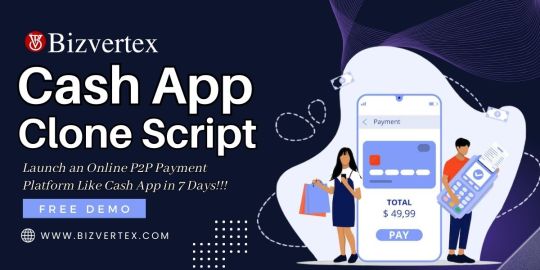
In the competitive landscape of digital finance, launching a peer-to-peer (P2P) payment app like Cash App presents a lucrative opportunity for entrepreneurs. With the rise of cashless transactions, businesses seeking to enter the fintech space can leverage a Cash App Clone Script to establish a robust and feature-rich payment solution. Bizvertex offers a scalable and cost-effective Cash App Clone Software tailored for startups and enterprises aiming to penetrate the digital payment sector.
Rapid Market Entry with White Label Cash App Clone Software
Developing a P2P payment application from scratch involves extensive research, development, and compliance measures, leading to high costs and prolonged time-to-market. A White Label Cash App Clone Software significantly reduces these challenges, allowing businesses to deploy a fully functional platform with minimal investment. By utilizing Bizvertex’s clone solution, entrepreneurs can customize the software to align with their brand identity, ensuring a seamless user experience while maintaining regulatory compliance.
Essential Features of a Cash App Clone Script
To compete in the fintech industry, a Cash App-like platform must offer key functionalities that enhance user engagement and transaction security. The Cash App Clone Script by Bizvertex includes:
Instant P2P Money Transfers – Enables users to send and receive money effortlessly.
QR Code Payments – Facilitates quick transactions via QR code scanning.
Multi-Currency Support – Allows users to transact in different fiat and digital currencies.
Bank Account Integration – Provides seamless linking with bank accounts for deposits and withdrawals.
Cryptocurrency Transactions – Supports Bitcoin and other digital assets for modern financial needs.
Robust Security Measures – Includes two-factor authentication, encryption, and fraud detection.
Bill Payments & Mobile Recharge – Enhances user convenience by integrating utility bill payments.
Custom Branding & UI/UX – Ensures a personalized experience for end-users.
Business Advantages of Choosing a Cash App Clone Software
1. Cost-Effective Development
Investing in a White Label Cash App Clone Software significantly reduces development costs compared to building a payment app from scratch. Bizvertex provides a ready-made yet customizable solution, ensuring a high return on investment (ROI) for entrepreneurs.
2. Faster Time-to-Market
Speed is crucial in the fintech industry. By opting for a Cash App Clone Script, businesses can launch their P2P payment app quickly and start acquiring users without delays.
3. Scalability & Customization
A pre-built clone solution from Bizvertex allows startups to scale as their user base grows. The software is fully customizable, enabling businesses to add unique features and branding elements.
4. Revenue Generation Opportunities
A Cash App-like platform offers multiple revenue streams, including transaction fees, subscription models, merchant partnerships, and cryptocurrency trading commissions.
Build a Profitable P2P Payment App with Bizvertex
For entrepreneurs aiming to establish a foothold in the fintech industry, Bizvertex’s Cash App Clone Software provides a reliable and efficient pathway. With advanced security features, a seamless user interface, and multi-currency support, businesses can create a successful and profitable P2P payment platform. Get started with Bizvertex today and build a fintech brand that stands out in the market.
3 notes
·
View notes
Note
what do you like about emacs?
a lot of things, really! I will refer you to the documentation for Doom Emacs for a short answer to this question that I agree with, or you can keep reading for my much, much longer answer. :)
as a software that predates modern text editors and IDEs, emacs breaks the mold when it comes to the established design patterns of these tools. in some cases this can be a problem: emacs is notoriously slow (though somehow still faster than modern IDEs on my machine lol), and its default keybindings are horrendous. but it is also emacs's greatest strength: the sheer versatility and extensability of its design is unmatched by any other tool in existence.
the first thing you need to know about emacs is that.. it's not really a text editor. I mean, that may be the mission statement on the website, and that's certainly what it was when it started out, but as it's developed it's become more than that. emacs is a software platform for text-based applications.
the entirety of emacs is designed to function as one big interpreter for the language Emacs Lisp (elisp for short). when you press a key on your keyboard in emacs, say the Enter key, that keypress is sent to emacs's standard library code written in elisp. the code looks up that key in a keymap, which associates it to a particular elisp subroutine to run (specifically "newline-and-indent"), which accesses the file you're currently editing and makes the corresponding change.
every aspect of that process is configurable directly through the elisp language. you can rebind the key to a different action, of course, but you can also edit the "newline-and-indent" subroutine to do something else, or edit any other elisp function. you can switch between multiple keymaps (a keymap is just a lisp object) on some condition, such as opening a particular file. you can even tell emacs to display text that isn't linked to any file and alter the keymap when the user is interacting with that text to contain your own custom bindings. in effect, you can create any text-based interface you want.
here is a non-exhaustive list of all of the things that I have used emacs as:
IDE
Prose editor
File manager
Calculator
Productivity tool
Email client
Calendar
Web browser
Tetris
all of these tools use, to varying degrees, the techniques I mentioned above to directly modify how emacs functions through elisp. with a little knowledge of the language, you can modify these tools to your liking just as easily as you can modify emacs itself. emacs becomes a unified interface for a hundred different applications, all of which are fully configurable and self-documenting. (yeah I didn't even mention that emacs is self-documenting within its code until now).
.. so it's not even really that I "prefer" emacs, because that framing implies that there are alternatives that are equal in scope or utility. I use emacs because it is the only thing that does what emacs does.
Emacs outshines all other editing software in approximately the same way that the noonday sun does the stars. It is not just bigger and brighter; it simply makes everything else vanish.
- Neil Stepheson, In the Beginning was the Command Line (1998)
#come on. you know i had to pull out The Quote#emacs#gnu emacs#programming#computers#tokinanpa#ask answered
16 notes
·
View notes
Text
GIS In Our Daily Lives
The involvement of Geographic Information Systems (GIS) in our daily lives is pervasive, influencing and enhancing various aspects across different sectors. The integration of GIS into everyday activities has become integral for decision-making, planning, and optimizing resources. GIS helps city planners and transportation experts to provide them with information like maps, satellite pictures, population statistics, and infrastructure data. GIS helps them make better decisions when designing cities and transportation systems that are sustainable and good for the environment.
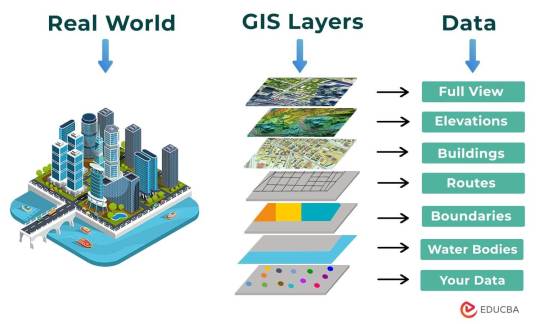
The following points elucidate the notable involvement of GIS in our daily lives:
Navigation and Location Services: GIS provides monitoring functions through the visual display of spatial data and precise geographical positioning of monitored vehicles, whereas GPS provides accurate, clear, and precise information on the position and navigation of a monitored or tracked vehicle in real-time and at the exact location.GIS is at the core of navigation applications and location-based services on smartphones. It enables accurate mapping, real-time navigation, and geolocation services, assisting individuals in finding locations, planning routes, and navigating unfamiliar areas.
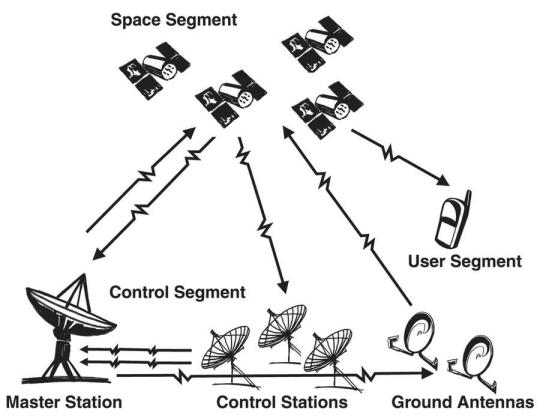
E-Commerce and Delivery Services: GIS software is a powerful tool for supply chain network planning. It helps determine the optimal location for distribution centers, warehouses, or other supply facilities. GIS is utilized in logistics and delivery services for optimizing routes, tracking shipments, and ensuring timely deliveries. E-commerce platforms leverage GIS to enhance the efficiency of their supply chain and last-mile delivery processes.

Weather Forecasting and Disaster Management: Many states are using GIS dashboard to monitor the rainfall across the state, on a real-time basis, from the data shared by rain sensors installed at various locationsGIS plays a crucial role in weather forecasting and disaster management. It assists meteorologists in analyzing spatial data, predicting weather patterns, and facilitating timely responses to natural disasters by mapping affected areas and coordinating emergency services.

Healthcare Planning and Disease Monitoring: Geographic Information Systems enable the visualization and monitoring of infectious diseases. Additionally GIS records and displays the necessary information that health care needs of the community as well as the available resources and materials. GIS supports public health initiatives by mapping the spread of diseases, analyzing healthcare resource distribution, and assisting in the planning of vaccination campaigns. It aids in identifying high-risk areas and optimizing healthcare service delivery.
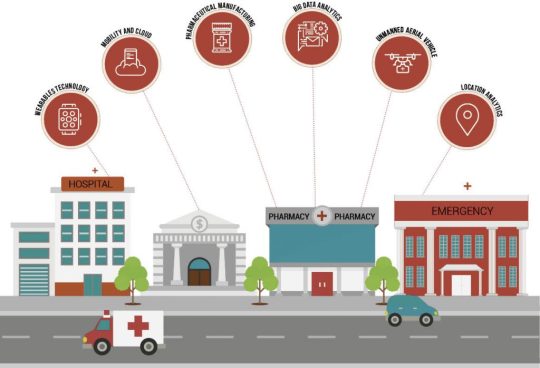
Social Media and Geo-tagging: GIS also helps in geotagging and other location related information in posts, it’s tools can map and visualize the spatial distribution of social media activity. This analysis can reveal trends, hotspots, and patterns in user engagement across different geographic areas. Many social media platforms incorporate GIS for geo-tagging, allowing users to share their location and experiences. This feature enhances social connectivity and facilitates the sharing of location-specific information.
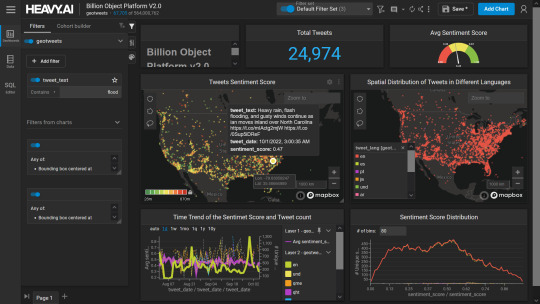
Smart City Initiatives: The Geographic Information System (GIS) offers advanced and user-friendly capabilities for Smart City projects and allows to capture, store and manipulate, analyze and visualize spatially referenced data. It is used for spatial analysis and modeling. It is the cornerstone of smart city planning, enabling the integration of data for efficient urban management. It supports initiatives related to traffic management, waste disposal, energy consumption, and overall infrastructure development.

Education and Research: GIS is increasingly utilized in education and research for visualizing and analyzing spatial data. It enables students and researchers to explore geographic relationships, conduct field studies, and enhance their understanding of various subjects.

Agricultural Management and Precision Farming: Farmers leverage GIS to optimize agricultural practices by analyzing soil conditions, crop health, and weather patterns. Precision farming techniques, facilitated by GIS, contribute to increased crop yields and sustainable farming practices.

Real Estate and Property Management: In the real estate sector, GIS aids in property mapping, land valuation, and site selection. It provides real estate professionals with valuable insights into spatial relationships, market trends, and optimal development opportunities.

Tourism and Recreation: GIS enhances the tourism industry by providing interactive maps, route planning, and location-based information. It assists tourists in exploring destinations, finding attractions, and navigating efficiently.

The broad and varied involvement of GIS in our daily lives underscores its significance as a technology that not only facilitates geographic data analysis but also contributes to the efficiency, safety, and interconnectedness of modern society. As GIS applications continue to evolve, their impact on daily activities is expected to further expand and refine.
#gis#architectdesign#architecture#city#education#geographic information system(gis)#geographical indication
13 notes
·
View notes
Text
Configuring Zephyr: A Deep Dive into Kconfig
We presented The Zephyr Project RTOS and illustrated a personal best practice for beginning with "Zephyr" in an earlier blog post. A custom West manifest file is a great way to guarantee that your code is always at a known baseline when you begin development, as you saw in that blog post. Following the creation of your custom manifest file and the establishment of your baseline repositories using West, what comes next in your Zephyr journey?

Enabling particular peripherals, features, and subsystems is one of the first steps in putting embedded software into practice. Some MCU manufacturers, like STM32, Microchip, and TI, have tools in their IDEs that let developers add subsystems to their codebase and enable peripherals in their projects. These tools, however, are closely related to the MCUs that the vendors sell. Applying these tools' functionality to other MCUs is challenging, if not impossible.
However, we can enable a specific MCU subsystem or feature using a vendor-neutral mechanism provided by The Zephyr Project RTOS. For people like me who don't like GUIs, this mechanism can be used with a command line. The name of this utility is "Kconfig." I'll go over what Kconfig is, how it functions, and the various ways we can use it to incorporate particular features and subsystems into our Zephyr-based project in this blog post.
WHAT IS KCONFIG?
Kconfig is still utilized today as a component of the kernel compilation process, having been initially created as part of the Linux kernel. Kconfig has a particular grammar. Although fascinating, the specifics of how Kconfig is implemented in the Linux kernel are outside the purview of this blog post. Alternatively, if you're interested, you can read my article here: (https://www.linux-magazine.com/Issues/2021/244/Kconfig-Deep-Dive), which walks through the Kconfig source code. However, after seeing an example, it's simple to become familiar with the format of a "Kconfig"—the slang term for a specific configuration option. The Kconfig system consists of three primary components.
First, there is the collection of Kconfig files scattered across different OS codebase directories. For example, if we look under "drivers/led" within the Zephyr codebase, we see a file named Kconfig with the following contents: menuconfig LED bool "Light-Emitting Diode (LED) drivers" help Include LED drivers in the system configurationif LED...config LED_SHELL bool "LED shell" depends on SHELL help Enable LED shell for testing.source "drivers/led/Kconfig.gpio"...endif # LED
Using the if statement, the line that begins with "menuconfig" tells the Kconfig system that "LED" contains a number of feature options that are only visible if the "LED" feature is enabled. The user can then activate the "LED_SHELL" option if the "LED" feature is enabled. The result of this configuration option is a Boolean, which determines whether this feature is enabled or disabled, as the line that follows shows. If a configuration option refers to a particular configuration parameter, the result can also be an integer in addition to a Boolean. The line that starts with "depends" indicates that in order for the "LED_SHELL" feature to be visible, the "SHELL" feature needs to be enabled. As a result, only after the "LED" and "SHELL" features have been enabled will the "LED_SHELL" feature become visible. A more detailed explanation of the feature can be found in the two lines that begin with "help". Last but not least, the final line before the "endif" lets us refer to additional Kconfig files, which aids in classifying components. As though they were copied and pasted, the features of the referenced file are present in the current file. It is crucial to remember that the path to "source" comes from the Zephyr codebase's root.
HOW SHOULD YOU USE KCONFIG?
A collection of applications that enable users to enable or disable the features listed in all Kconfig files make up the second component of the Kconfig infrastructure. Zephyr provides a Visual Studio Code extension that enables users to carry out this task with a graphical user interface. For command line enthusiasts like myself, the VS Code extension provides an alternative to utilizing a graphical user interface. In order to configure Zephyr appropriately, the extension can accept a file, which is the final component of the Kconfig infrastructure and contains a set of configuration options that can be turned on or off. The following snippet shows an example. CONFIG_BT=yCONFIG_BT_PERIPHERAL=yCONFIG_BT_GATT_CLIENT=yCONFIG_BT_MAX_CONN=1CONFIG_BT_L2CAP_TX_MTU=250CONFIG_BT_BUF_ACL_RX_SIZE=254
There is nothing complicated about the file format. "CONFIG_" appears at the start of each line, and then the configuration option's name. After the "=" symbol, the line either ends with a "y" to activate the feature or a "n" to deactivate it. In the example above, we configure the stack parameters and activate the Bluetooth stack in Zephyr along with specific stack features. "prj. conf," which contains user-defined features, is the default file in the majority of Zephyr-based applications.
CONCLUSION
The Zephyr Project RTOS provides a robust, vendor-neutral mechanism called the Kconfig infrastructure that allows us to fully configure our entire application. It can be used to control particular subsystems and peripherals within the MCU in addition to turning on or off individual stacks within the RTOS and setting configuration parameters.
Ready to bring your embedded systems to life with optimized configurations and robust solutions? We specialize in hardware design and software development tailored to your project needs. Whether you're configuring peripherals or diving deeper into Kconfig for your Zephyr-based applications, our experts are here to support you every step of the way.
👉 Contact Us Today and let's transform your embedded ideas into reality!
2 notes
·
View notes